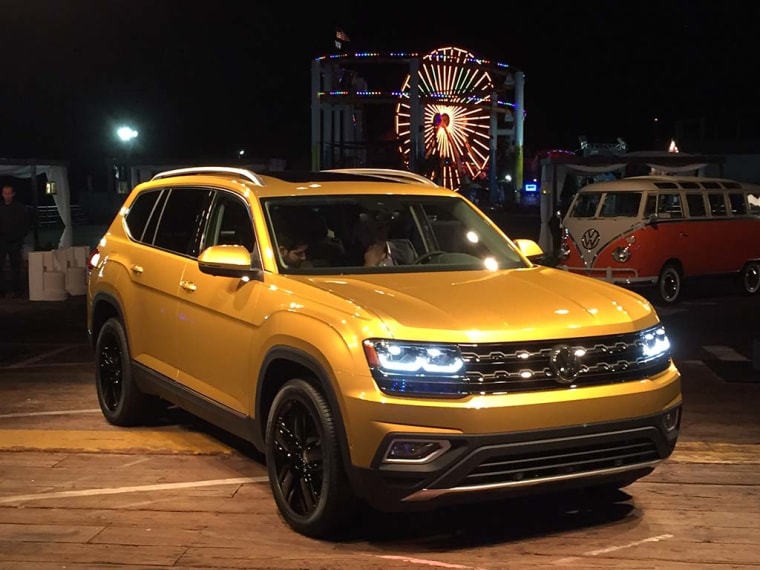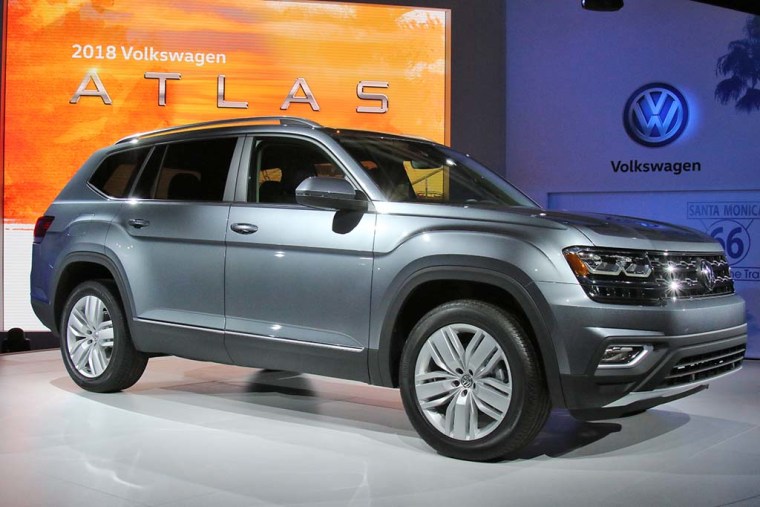Volkswagen is struggling to shake off the massive damage to its reputation — and its finances — after revelations it cheated extensively on diesel emissions tests.
So it's introducing the Atlas — which, at nearly 17 feet long, is by far the biggest non-commercial vehicle the embattled automaker will have ever offered in the U.S. But it’s no surprise. Like the mythological figure it was named for, VW’s new SUV will have a lot of weight to carry on its shoulder.
Making its public debut at the Los Angeles Auto Show this month, the Atlas is one of several big new models heading to the German automaker’s U.S. showrooms. It will be joined next year by the new Arteon, a stylish, high-line fastback that will become the most lavishly equipped — and expensive — model in the Volkswagen of America line-up.
Demand Has Plummeted
The two models will be just the first wave of a major product assault from VW, whose sales have collapsed in the States, nabbing just 1.8 percent of the new vehicle market so far this year. With a total of 256,047 vehicles sold here from January through the end of October, demand was down by just over 13 percent, despite offering some of the most lavish incentives in its history.
The fact that it can’t sell any of those diesels in the U.S. until it comes up with a technical fix isn’t helping. But it’s by no means the only problem the automaker has faced.
Equally problematic has been a product line-up largely out of tune with changing market trends. Nowhere is that more obvious than in the booming utility vehicle market that is one of the few segments still growing at a time when overall U.S. new vehicle sales have begun to flatten out after three consecutive years of record growth.
Related: Feds Announce $15 Billion Settlement with VW on Emissions Scandal
Where some competitors, such as Ford, Chevrolet, and Toyota, have as many as a half-dozen different crossover- and sport-utility vehicles to target every niche, VW has had to compete with two utes: the big Touareg and little Tiguan.
The new Atlas “is the beginning of a new future for Volkswagen in America,” declared Hinrich Woebcken, head of the company’s North American operations, during a splashy preview on the crowded Santa Monica Pier that once marked the end of iconic Route 66.

If anything, VW officials suggested they were at the beginning of the road back, but they have a lot of challenges to address. The carmaker has had a roller-coaster ride in the American market. In the 1950s, ‘60s and early ‘70s, it was the top-selling import brand, at times commanding as much as 5 percentof total U.S. sales. But it ran off the road when it replaced the iconic Beetle with the Rabbit, a model that, despite its spry name, couldn’t keep pace with a flood of new Japanese imports.
Over the years, VW seemed to lose interest in the American market. It refused to design cars that clearly targeted U.S. needs, often refusing to offer even subtle design tweaks or accessories. Complicating matters, it was routinely faulted for falling short of Japanese quality levels.
The maker insisted it was shifting gears when, in October 2011, it opened an all-new assembly plant in Chattanooga, Tennessee, building a unique, U.S. version of the big Passat sedan.
Despite the hefty cost of the diesel disaster, VW says it is maintaining its big commitment to the U.S. market, according to Woebcken, a long-time BMW executive who was named CEO of Volkswagen Group of America early this year.
Overall, that plan will come to $6 billion, including the $900 million expansion at the Chattanooga plant that will be the sole global production source for the new Atlas. When the three-row SUV begins to roll down the line early next year it will specifically be earmarked for the North American market, though the plant eventually will ship some of the big utes abroad.
Light trucks, in general, now make up about 60 percent of the American new vehicle market, and utility vehicles, in particular, make up the fastest-growing segment. Adding a seven-seat SUV is critical, according to analysts like Joe Phillippi, of AutoTrends Consulting, who has long warned of a “big gap” in the VW line-up because the brand’s two original utes missed a lot of potential buyers.
The Weight of the World
A subtle sign of how seriously VW takes this challenge is the fact that the new model was named Atlas. The maker’s original SUVs sported unfamiliar, hard to pronounce badges like Touareg — named for a tribe of nomads in North Africa — and Tiguan. (VW officials are still debating what name they will bolt onto the big, new SUV when it begins to be sold abroad.)
The plan to add the new Arteon likely won’t have near the impact on VW’s U.S. sales as the Atlas. If anything, the overall full-size sedan market has tumbled 14.1 percent through the end of October. But the fastback will serve as a new halo car for the brand, offering a lavish mix of features and a much more curvaceous design than the rest of the current VW passenger car line-up.
It also will slot into a niche left empty since VW pulled its first-ever luxury sedan, the Phaeton, a few years back. That model was targeted against daunting competitors, such as the Mercedes-Benz S-Class. The Arteon will be aiming for a more mainstream, if up-scale, niche.
The two big models will be just the first in a wave of new products for the American market. The carmaker is still debating whether to add a fourth SUV, though as demand for compact utes, such as the new Chevrolet Traxx and Honda HR-V grow, the business case is getting more favorable, they said.
And then there will be the electric cars. VW showed off a new long-range, affordable battery model at the recent Paris Motor Show, the I.D. set to debut in 2018. As many as 30 electrics will be added to the global VW line-up by 2025.
How much of an impact they’ll have in the U.S. is far from certain, especially if fuel prices remain low. At least for now, SUVs will be key to a Volkswagen turnaround. Atlas is as big a product as VW has in its arsenal. It is targeting a large and still growing part of the U.S. market. Like its namesake, it will now have to do some heavy lifting.
